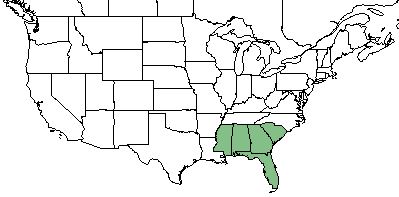Difference between revisions of "Hypericum myrtifolium"
(→Ecology) |
HaleighJoM (talk | contribs) (→Ecology) |
||
| Line 40: | Line 40: | ||
<!--===Seed dispersal===--> | <!--===Seed dispersal===--> | ||
<!--===Seed bank and germination===--> | <!--===Seed bank and germination===--> | ||
| − | |||
===Fire ecology=== <!--Fire tolerance, fire dependence, adaptive fire responses--> | ===Fire ecology=== <!--Fire tolerance, fire dependence, adaptive fire responses--> | ||
This species is commonly found in fire-dependent pineland habitats.<ref name= "Carr 2010"/> | This species is commonly found in fire-dependent pineland habitats.<ref name= "Carr 2010"/> | ||
| − | <!--===Pollination and | + | <!--===Pollination===--> |
| − | <!--==Diseases and parasites==--> | + | <!--===Herbivory and toxicology===--> |
| + | <!--===Diseases and parasites===--> | ||
==Conservation, cultivation, and restoration== | ==Conservation, cultivation, and restoration== | ||
Latest revision as of 19:44, 1 July 2022
Common name: Myrtle-leaf St. John's-wort[1]; Polebark St. John's-wort
| Hypericum myrtifolium | |
|---|---|

| |
| Photo by the Southeastern Flora Plant Database | |
| Scientific classification | |
| Kingdom: | Plantae |
| Division: | Magnoliophyta - Flowering plants |
| Class: | Magnoliopsida - Dicots |
| Order: | Theales |
| Family: | Clusiaceae |
| Genus: | Hypericum |
| Species: | H. myrtifolium |
| Binomial name | |
| Hypericum myrtifolium L | |

| |
| Natural range of Hypericum myrtifolium from USDA NRCS Plants Database. | |
Contents
Taxonomic Notes
Synonyms: none.[1]
Varieties: none.[1]
Description
H. myrtifolium is a native perennial shrub that is a member of the Clusiaceae family.[2] It is most recognizable by its clasping leaves, which are usually glaucous.[3]
Distribution
H. myrtifolium is endemic to the southeastern Coastal Plain, found mainly in Florida, and sparingly throughout southern Alabama, Georgia, and Mississippi.[2][4]
Ecology
Habitat
H. myrtifolium frequents pond-adjacent habitats, fresh-waterbodies. and the occasional marsh.[5][4] Other natural communities include the sandhills and flatwoods.[6] More specifically, H. myrtifolium can be found in dry loamy sands of open pine woodlands, moist loams of pine woodland swales, sand pine stands, and shaded swamps.[7] It is considered an indicator species of the peninsula savannas in Florida.[8]
Associated species include Hypericum harperi.[7]
Phenology
H. myrtifolium commonly flowers from April until June.[9] It has been observed flowering from May to July as well as October to December.[10][7].
Fire ecology
This species is commonly found in fire-dependent pineland habitats.[8]
Conservation, cultivation, and restoration
As it is uncommon in its range and depends on endangered habitat types, Hypericum myrtifolium is listed as G4. It is also considered imperiled in Mississippi.[11]
Cultural use
Photo Gallery
References and notes
- ↑ 1.0 1.1 1.2 Weakley, A.S. 2015. Flora of the southern and mid-atlantic states. Working Draft of 21 May 2015. University of North Carolina at Chapel Hill, Chapel Hill, North Carolina.
- ↑ 2.0 2.1 USDA Plants Database URL: https://plants.usda.gov/core/profile?symbol=HYMY
- ↑ Carr, L. G. (1940). "Further notes on coastal floral elements in the bogs of Augusta County, Virginia." Rhodora 42(495): 86-93.
- ↑ 4.0 4.1 Weakley, A. S. (2015). Flora of the Southern and Mid-Atlantic States. Chapel Hill, NC, University of North Carolina Herbarium.
- ↑ Hilmon, J. B. (1964). "Plants of the Caloosa Experimental Range " U.S. Forest Service Research Paper SE-12
- ↑ Platt, W. J., Gregory W. Evans, and Mary M. Davis (1988). "Effects of Fires Season on Flowering of Forbs and Shurbs in Longleaf Pine Forests." Oecologia 76(3): 353-363.
- ↑ 7.0 7.1 7.2 Florida State University Robert K. Godfrey Herbarium database. URL: http://herbarium.bio.fsu.edu. Last accessed: June 2018. Collectors: Loran C. Anderson, Wilson Baker, R. A. Norris, Robert K. Godfrey, R. Komarek, M. Davis, J. M. Kane, Cecil R. Slaughterm and R. Kral. States and counties: Florida: Leon, Wakulla, Duval, and Madison. Georgia: Thomas and Clinch.
- ↑ 8.0 8.1 Carr, S. C., et al. (2010). "A Vegetation Classification of Fire-Dependent Pinelands of Florida." Castanea 75(2): 153-189.
- ↑ [[1]] Lady Bird Johnson Wildflower Center. Accessed: May 28, 2019
- ↑ Nelson, G. PanFlora: Plant data for the eastern United States with emphasis on the Southeastern Coastal Plains, Florida, and the Florida Panhandle. www.gilnelson.com/PanFlora/ Accessed: 22 MAY 2018
- ↑ [[2]] NatureServe Explorer. Accessed: May 28, 2019